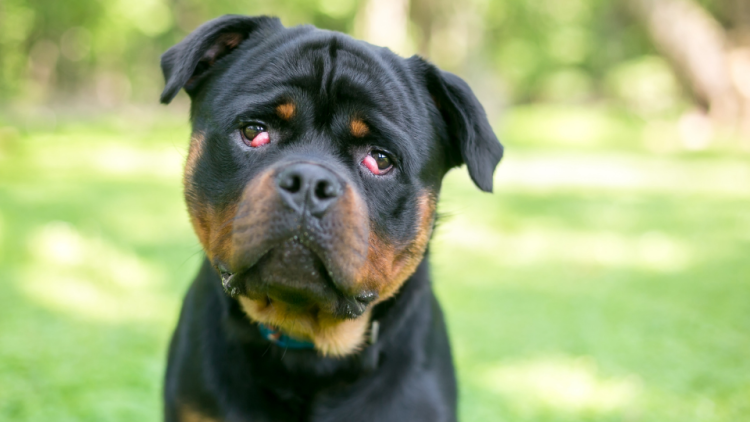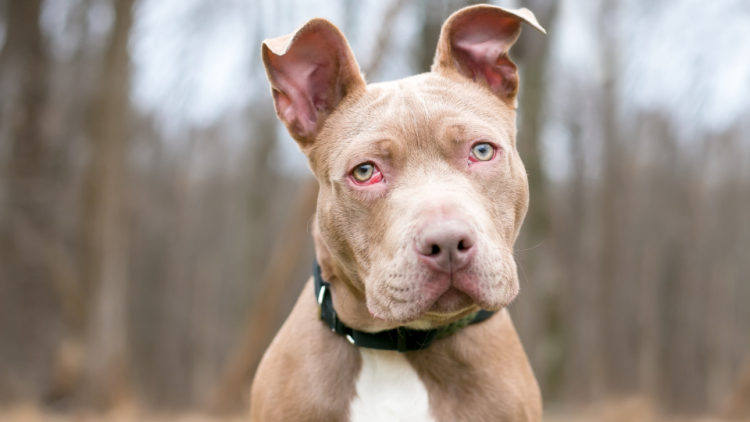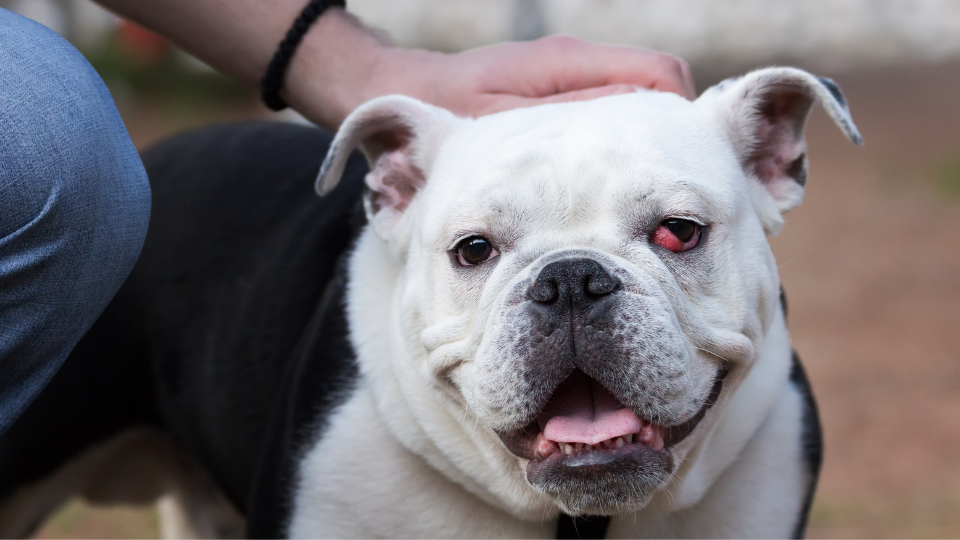If your pup has a red bump in the corner of their eye, it could be a condition known as cherry eye. This condition can affect one or both eyes and most commonly appears in younger dogs. But should owners be worried if their pet has cherry eye? Is the condition treatable?
Keep reading to find out what causes cherry eye in dogs, how to recognize the symptoms, how to treat it, and more.
Table of Contents
- What is cherry eye in dogs?
- What causes cherry eye in dogs?
- Symptoms of cherry eye in dogs
- Diagnosing cherry eye in dogs
- Cherry eye in dogs treatment
- Cherry eye surgery cost
- Recovery and prognosis
- How to prevent cherry eye in dogs
- Key Takeaways
Pro Tip: Pet insurance can help you cover the cost of treatment for your pet's eye condition, so long as it did not exist at the time of enrollment.
What is cherry eye in dogs?
Before we explain what cherry eye is, we should first mention that dogs and cats have an extra eyelid called the 'third eyelid' or the nictitating membrane, at the inside corner of their eyes closer to their nose.
Cherry eye occurs after the tear gland which is located in this third eyelid, and normally cannot be seen, becomes inflamed and pops out (prolapses) of its normal position. Besides providing extra protection for your dog's eye, this gland is also responsible for secreting tears. In fact, the tear gland in the third eyelid is responsible for about 40% of the overall tear production in dogs.
In dogs with cherry eye, this membrane becomes inflamed and pops out of place, looking like a red or pink bulge in the inner corner of the eye. The condition can affect one or both eyes but, according to Ghanna Animal Hospital, “40% of dogs that experience cherry eye in one eye will eventually have it in the other.”
Cherry eye may be painless and non-harmful to your dog, but can also cause irritation and dry eye so it is important to visit your veterinarian if you notice your dog might have a cherry eye, especially if it seems to be painful or irritating to them.

What causes cherry eye in dogs?
The condition develops when the ligament that holds the tear gland in place breaks or stretches.
Cherry eye can happen to any dog, but some breeds are more prone to developing the condition, including:
- French Bulldog
- English Bulldog
- Shih Tzu
- American Cocker Spaniel
- Boxer
- Beagle
- Basset hound
- Bloodhound
- Boston Terrier
- Cane Corso
- Chinese Shar-Pei
- Great Dane
- Lhasa Apso
- Neapolitan Mastiff
- Newfoundland
- Pekinese
- Pug
- Saint Bernards
- Rottweilers
In general, teacup and toy dogs, as well as short-muzzle breeds (also known as brachycephalic breeds) are more prone to cherry eye. Most affected dogs will have their first cherry eye appear under two years old, although the condition can occur in one or both eyes at any age.
The condition is not contagious to people or other animals.
Symptoms of cherry eye in dogs
The main symptom of cherry eye in dogs is the swollen and protruding third eyelid resembling a cherry pit. This small, round, pink or red mass is located in the inside corner of the dog’s eye. In some cases, the eye itself will seem red, itchy, or swollen.
Dogs with cherry eye may produce a thick mucus discharge from the eye. This occurs if the tear gland can’t produce enough tears to keep the eye moist, or if your pup gets an infection in their eye as a result of the condition.
Other conditions, such as a foreign body, eye infections, or trauma to the eye, can also cause similar symptoms. For this reason, it’s always best to get in touch with your vet whenever you notice anything out of the ordinary about your pet’s eyes.
Diagnosing cherry eye in dogs
Cherry eye is diagnosed by examination of the dog’s eye. Besides visual examination, the vet might also perform diagnostic tests, such as a Schirmer's test which is a simple, non-invasive test to measure tear production and ensure that your pet doesn’t have dry eye.
The vet may also choose to perform fluorescein staining to check the surface of your dog’s eye for corneal scratches. Dogs with cherry eye may give themselves corneal scratches if their eye is itchy and they are scratching their face with their paws or objects around the house.

Treatment for cherry eye in dogs
Cherry eye is usually cured with surgery. In over 90% of cases, the prolapsed gland is returned into the correct position and stitched in place so it cannot pop out again. However, in more severe cases where the dog has had the condition for a long time or the tear gland is no longer functional, or when the surgical replacement procedure described above has been done previously and has failed, the gland might need to be removed.
Cherry eye surgery doesn’t guarantee 100% success and in some cases, a second surgical procedure might be needed. The chances for full recovery are highest if the procedure is performed as soon as the condition occurs before the gland becomes enlarged or inflamed. That’s why it is very important to visit your veterinarian as soon as you notice anything unusual about your pet’s eyes.
If left untreated, cherry eye can cause eye infections and chronic dry eye (also known as keratoconjunctivitis sicca or KCS). In some cases, if your veterinarian has confirmed your dog’s eye is healthy and the cherry eye does not seem to bother them, surgery is not always necessary.
In these cases, surgery is usually recommended for cosmetic purposes to make the eye look “normal” again and your veterinarian may give you the option to not surgically intervene if they believe your dog’s eye is healthy and not at risk of developing any of the secondary issues discussed above.
Cherry eye surgery costs
In general, the cost of cherry eye surgery ranges from $300 to $800. You’ll also need to factor in additional treatment costs, such as ongoing medication, which typically falls between $25 and $75 depending on the necessary prescription.
However, the cost to treat cherry eye in dogs will depend on multiple factors, including how severely the eye is affected, the type of procedure, and the doctor performing it. Personal factors can also contribute to the cost of surgery. For instance, larger dogs require more anesthesia, which often results in an increase in price.
The “pocket” technique boasts the highest success rate but it’s also the most expensive option. Alternatively, removing the third eyelid membrane is less expensive but usually considered a last resort as it reduces tear production by 30%.
If the condition has affected both eyes, the price will be higher. In addition, if you decide your dog’s surgery to be performed by a veterinary ophthalmologist instead of a general practice vet, your bill will also be higher.
Pro Tip: Pet insurance can help cover the costs of medication and surgery for cherry eye. If your dog has a genetic predisposition to this condition, it is best to insure your pup while they’re still a puppy so this or any other health issue that they may develop is covered.
Recovery and prognosis
After the surgery, your pet will need to wear a cone, also known as an Elizabethan collar or e-collar, to prevent them from rubbing their eye and disrupting the stitches. Vets usually also prescribe eye drops or medicated eye ointments, as well as oral antibiotics to keep the eye moist, prevent infections, and ensure that the eye heals properly.
If the tear gland is surgically removed or if surgical treatment is not an option, your dog will likely need to use eye drops to keep the eye moist and healthy for the rest of their life.
When it comes to recovery after surgery, the prognosis is very good. There might be inflammation for a week or two before the eye regains its normal appearance. Allow your dog to rest for a few days after the procedure and avoid swimming or bathing for about two weeks.
Your vet will probably want to recheck your dog’s eye two weeks after the procedure and will likely recommend an ocular exam at every future check-up.
It should be noted that dogs who are genetically predisposed to cherry eye are more likely to have a relapse. In addition, about 20% of dogs who had this condition could also develop dry eye later in life.
How to prevent cherry eye
Unfortunately for your pet, there’s nothing you can do to prevent cherry eye. However, it is possible to prevent additional problems associated with this condition (such as infections and dry eye) by keeping the eye moist with adequate eye drops and treating any eye issues that may appear at the earliest opportunity.
Key Takeaways
- Cherry eye, i.e. prolapse of the third eyelid gland, is an uncomfortable condition that can lead to other issues, such as infections and dry eye.
- The condition can affect any dog but is especially common in toy and teacup breeds, as well as dogs with short muzzles. The list of breeds prone to cherry eye includes Pugs, Bulldogs, Bulldogs, Rottweilers, etc.
- Most dogs with cherry eye require surgery in order to put the gland back in place. Be sure to get in touch with your veterinarian as soon as possible if you think your four-legged friend has any eye problems, including cherry eye.
